Benchmarks I
And now for the obligatory benchmarks, first a few benchmarks specifically written to show the power of tile based rendering, compared with a Per Pixel renderer such as a GeForce2. I used the Hercules GeForce2 Ultra as a guinea pig to show the difference between Tile based Rendering and the more common Per Pixel rendering.Village Mark1.10
I ran village mark in the various common resolutions and pitched it against a top end 3D accelerator the GeForce2 Ultra. As you can see the Kyro II beats it in all but the lowest resolutions, as this is a low end card priced around £130 it is a quite an impressive feat to beat a card costing considerably more. This test is rather biased towards the Kyro II though as it makes extensive use of overdraw by overlapping the numerous houses thus forcing the GeForce 2 and other graphics cards to render far more than would be normal in a regular game engine.
| Village Mark | 640*480 | 800*600 | 1024*768 | 1280*1024 | 1600*1200 |
| Kyro II | 137 | 136 | 126 | 80 | 56 |
| GeForce 2 Ultra | 87 | 65 | 45 | 29 | 21 |
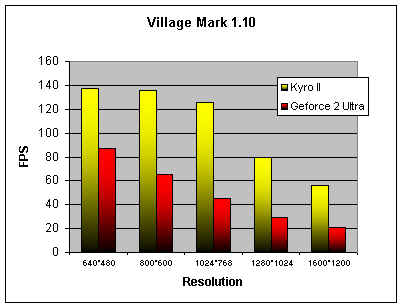
The results clearly show that if a game is programmed to use Tile based rendering it is indeed a very frugal way to texture 3D objects, if all games went this way then, Graphics cards wouldn't have the need for 460MHz DDR RAM as now being used on the GeForce3, but since most games are targeted to run on GeForce, or Radeon Graphics Cards, that is what the Kyro II will have to contend with for a while at least.
Temple Demo 1.0.2
This demo consists of flying around pyramids and the inside of one pyramid it looks pretty cool, the Kyro II again flexes its muscles and beats the GeForce2 Ultra by quite a margin. The demo is included with the Kyro II card and is designed to show its power. The demo only runs in 1024*768 resolution, using a command line parameter I was able to benchmark it.
| Temple Demo | 1024*768 |
| Kyro II | 80.3 |
| GeForce2 Ultra | 59.9 |
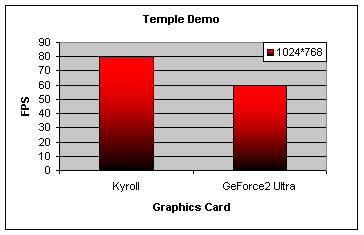
Vulpine GLMark 1.1
The next benchmark I ran was the fairly new OpenGL benchmark Vulpine GL Mark 1.1 it is a free download from www.vulpine.de , this is really aimed at the GeForce3 chipset, but since it runs on a GeForce2 and uses an OpenGL API I decided to run it, as always I benched it alongside a GeForce2 to show some kind of reference benchmark
Benchmark Defaults
1024*768 * 32bit Full screen Standard OpenGL 1.2, Texture Compression on, High Detail
| Vulpine GLMark | Ultra | Kyro II |
| min | 19 | 4 |
| max | 147 | 68 |
| average | 37.4 | 15.9 |
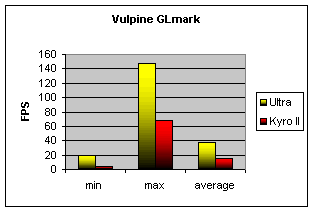
Here the Kyro is definitely struggling, this is with a high end OpenGL based game engine, the max FPS is less than half of the Ultra scores the average score is also way down at 15.9 FPS, the minimum score is very very slow in comparison with the GeForce score a pretty miserable 4FPS, I suppose all that can be said here is that the T&L engine of the GeForce is being used and as the Kyro hasn't got it, it is much slower. Your could argue this is a biased test but it uses an OpenGL API, so I decided to test out the Kyro II OpenGL implementation.
3DMark 2000
On with a more familiar benchmark this time 3DMark 2000, now getting a bit old but its good to see what the Kyro II can manage, as usual all the common resolutions where tested and since I had the benchmark data from the previous Hercules roundup I used that as a comparison
|
3DMark 2000 |
640*480 | 800*600 | 1024*768 | 1280*1024 | 1600*1200 |
| Kyro II @1300MHz | 6513 | 6458 | 5792 | 4399 | 3386 |
| Herc GeForce2 MX @ 1300MHz | 8807 | 6960 | 5138 | 3498 | 2551 |
| Herc GeForce1 DDR @ 1300MHz | 9051 | 7466 | 5738 | 3980 | 2832 |
| Herc GeForce2 Pro @ 1300MHz | 10404 | 9659 | 8057 | 5929 | 4579 |
| Herc GeForce2 Ultra @ 1300MHz | 10655 | 10139 | 9011 | 6793 | 5319 |
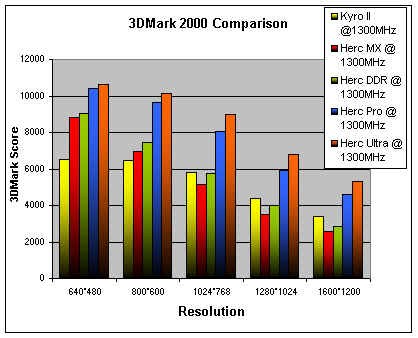
Here you can see that the Kyro II is beaten in the lower resolutions by both the GeForce 2 MX and also the older GeForce1 DDR, but as soon as the resolution starts to rise above 1024*768 the Kyro starts to beat them by a healthy margin, it still lags behind the GeForce 2 Pro and Ultra though. The Kyro achieves its aims here beating the GeForce 2 MX in the higher resolutions.
3DMark 2001
This is a much newer benchmark and as such uses all the latest features available to game designers, this is the first real problem that the Kyro II comes up with, as soon as you start 3DMark 2001, you get this error message.
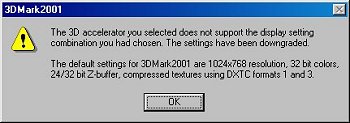
The good news is that the Benchmark still actually ran ok, I ran the default benchmark and came up with the following scores, I ran the same tests using the GeForce2 Ultra, although this isn't a fair comparison its the only card I had available at the time, I haven't tested 3DMark 2001 with a GeForce 2 MX, so I can't really comment on it's performance, what is evident is that the Kyro isn't really affected by the need for increased bandwidth, the scores remain fairly consistent around the 2000 marks, the GeForce on the other hand lose out a lot as the resolution gets higher and the memory bandwidth gets used up. There, are some bugs in the current version of Directx 8 that force the Kyro II to render some textures in software which makes it slower. This particularly shows in 3DMark 2001, which uses a lot of rendering into textures in the car chase and lobby scenes. Dynamic shadows are one such example where, the textures currently have to be rendered by the CPU rather than the graphics hardware and as such they don't run as fast as they might. Directx 8.1 build 620, enables rendering into textures again, but unfortunately as Microsoft pulled all the links to it I was unable to test it out. With driver updates and the release version of Directx 8.1 there should be a performance increase, for a number of D3D based games/ benchmarks 3DMark 2001 included.
| 640*480 | 800*600 | 1024*768 | 1280*1024 | 1600*1200 | |
| Kyro II @1300MHz | 2389 | 2383 | 2331 | 2176 | 1921 |
| GeForce2 Ultra @1300MHz | 4583 | 4400 | 3973 | 3155 | 2461 |
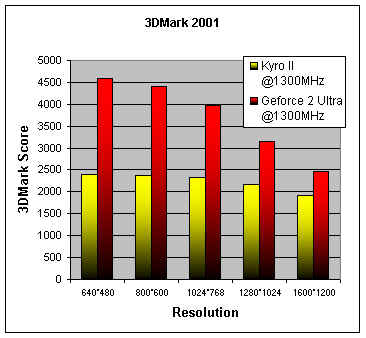
Quake 3
Here's the usual Quake 3 benchmarks, again using data from the hercules roundup, I've just included the 32Bit max detail settings, since the game the game looks so much better with all the eye candy turned on. This means all quality sliders to the far right and max quality for everything. As a comparison I've included results for the GeForce series of cards.
| Default Speed | 640*480 | 800*600 | 1024*768 | 1280*1024 | 1600*1200 |
| EHQ Kyro II | 128.6 | 113.8 | 84.3 | 52.2 | 35.1 |
| EHQ MX | 122.9 | 88.4 | 56.5 | 33.9 | 20.7 |
| EHQ DDR | 133.8 | 108.2 | 70.1 | 38.3 | 24.6 |
| EHQ Pro | 142.5 | 133.5 | 100.2 | 62.7 | 43.1 |
| EHQ Ultra | 146.1 | 139.2 | 115.7 | 74.4 | 51.5 |
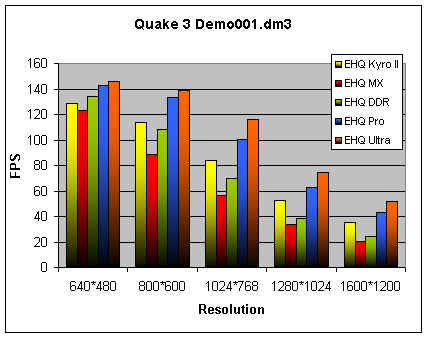
As you can see from the results the Kyro II is nearly getting the same scores as a GeForce2 Pro, which is clocked much much higher.
Unreal Tournament
I ran UT in all the common resolutions and this time the Kyro II beats the GeForce Ultra for some of the benchmarks, in the lower resolutions it beats the GeForce2 Ultra by around 5FPS, this seems somewhat odd but, I repeated the tests and the Kyro II consistently came out on top in the lower resolutions, in the higher resolutions the Ultra pulls away from the Kyro.
| Unreal Tournament | 640*480 | 800*600 | 1024*768 | 1280*1024 | 1600*1200 |
| Kyro II | 105.58 | 101.24 | 85.96 | 57.91 | 43.41 |
| GeForce2 Ultra | 99.9 | 97.82 | 94.57 | 86.89 | 59.9 |
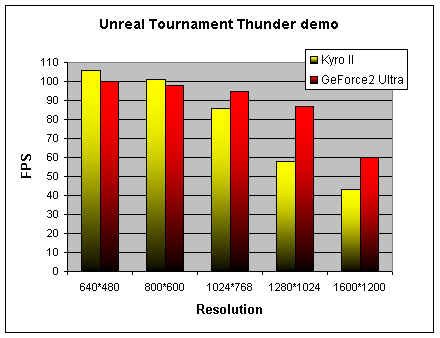
Some More Benchmarks
Besides the gaming benchmarks there are other important tasks that a Graphics card must be able to run in a modern multimedia PC. These include running Video files and general day to day task such as web browsing and, image processing, As I was writing this review I noticed a problem with the Kyro video card displaying large animated Gif's as included in this review, the problem was a slow refresh rate as if the video card couldn't keep up with refreshing the image, the display was running at 1280*1024 at the time in 32 bit colour, but this minor task seemed to cause problems for the Kyro II. This is somewhat disturbing, so I decided to run some more tests
Video Playback
On with some non gaming tests now, I have a few DVD films that have been converted into DivX format, this is a highly compressed format, which enables a whole film to be compressed on to one or 2 CD's and maintain a very good picture quality, I recently got "Gone in 60 Seconds" in DivX format, so I decided to try it out with the Kyro II graphics card, I was rather disappointed with the picture quality, it was very pixelated compared with the Nvidia card, I don't know if this is a driver Issue with the Kyro, or if it is a lack of hardware support for video playback, but on the whole the film looked a lot worse on the Kyro than on the GeForce chipset, below are a few screen shots showing the problems.
Update
Having looked into in the problem in some depth, it seems there is a problem at the moment with video playback of DivX films, that have a width in pixels that is not divisible by 32, the films I have are 720 pixels wide, which gives a number of 22.5, this is not a whole number, I encoded one film at a number divisible by 32 704*288 pixels, and the playback was fine, it remains to be seen if the problem of films in resolutions not divisible by 32 will be solved with driver updates, or possibly an update to the DivX codec.
![]()
The picture above looks a bit strange if you haven't seen the film, its a close up of key
As you can see above the Kyro II chipset isn't doing a very good job of decompressing a DivX film, that is encoded at 720 pixels wide the playback is fast enough, just it isn't very high quality, the image does tend to tear sometimes as well, I watched various bits of the film and some other DivX films and they were all the same, very pixelated and blocky in comparison with the GeForce card.
Here's one more shot from the film, a shot of the rather nice Angelina Jolie. Click on the picture below to see the GeForce and Kyro screenshots and see more on the Kyro II video playback quality issue. There are screenshots showing the difference between the different pixel width films, which currently affect the playback quality.
Click here to see more on the video issue.
DVD playback is ok with the latest Version of Power DVD, you need to enable Hardware Acceleration within the PowerDVD configuration, the playback is still not as crisp looking but it is acceptable quality, the problem lies with DivX films, if you don't watch DivX films then this wont be an issue, but as I have DivX films I was not happy with the Kyro II performance in this particular situation.
After posting a few messages on the Kyro II forums and reading other posts about video playback, it appears there are issues with the different types of overlay available to the Kyro II. It cannot use hardware acceleration, for DivX films encoded at width's not divisible by 32. Driver fixes are in progress to try and sort the situation, but as of now the DivX playback problems still exist. I used Media Player to play DivX films, there are other players around which may help with the problem. I only found out about the other DivX players after the card had gone back. Its called Sasami video player, as I said I haven't tested the player but it may solve the problems.
All the games I ran worked fine without any tweaking, on looking around on the net I found this forum http://www.paraknowya.com/discus/, its full of useful stuff on getting the best from the Kyro II. The tips I found on this forum enabled me to run Serious Sam much faster, but as time was pressing I left the benchmarks out. On with another 2D benchmark now.
Madonion Video Mark 2000
| Kyro II | GeForce2 Ultra | |
| Video Mark | 1813 | 2152 |
| Quality | 634 | 780 |
| Performance | 733 | 772 |
| Features | 447 | 600 |

There's not much you can say about the results for Video Mark, in comparison with the GeForce2 they are somewhat lower, the Kyro II doesn't have as many features according to video Mark, but as it is a fairly synthetic benchmark, there isn't much you can say, you can download Video Mark 2000 here and try it out yourself it yourself.
This review just wouldn't be the same unless I tried overclocking the Kyro II, so click here to find how it went










